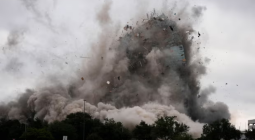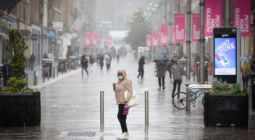Climate Trauma Is a Thing. Here’s What the Research Reveals
“It’s its own beast that we now want to study on its own and deserves its own recognition, awareness and characterization,” says one professor who studies the psychological and social impacts of wildfires
The catastrophic wildfires that have hit Southern California are acute symptoms of the climate emergency.
Climate disruption is driving rapid oscillation between massive rainstorms that promote underbrush, followed by periods of drought that dry that underbrush into tinder for wind-driven sparks.
Not only are people hurt, and property destroyed, the huge wildfires also sear communities and the mental health of both victims and observers.
Jyoti Mishra and colleagues from California State University, Chico, studied the psychological and social impacts of the 2018 Camp Fire, California’s deadliest to date, as well as the devastating 2023 Maui blazes. This interview has been edited for length and clarity.
JYOTI MISHRA: Wildfires are climate disasters that we’re seeing with increasing frequency in the world that we live in today, and these can really deeply impact mental health. In our work, we’ve shown that communities suffer from post-traumatic stress disorder (PTSD) symptoms, also anxiety symptoms and depression symptoms even many months after witnessing a climate disaster, and it can be so prevalent that up to 40 percent of community members can be suffering from these mental health symptoms.
JENNI DOERING: That’s a huge toll. What about the cognitive impact—how do our brains react to these disasters?
MISHRA: There are definitely cognitive impacts observed, not just in people who are directly exposed to the fires, but also to those who are indirectly exposed.
The directly exposed are those who have suffered from loss of property or immediate impacts on their own family, whereas indirectly exposed individuals are those who have witnessed the fires in their community, in their immediate community, but have been fortunate to not have personal loss of any kind. We see that there can be cognitive impacts in both of these exposed individuals, whether directly exposed or indirectly exposed.
Cognitive impacts can be a poor ability to suppress distractions or ignore distractions in our environment, and therefore not being able to pay attention very well. This also then impacts how we make decisions. Underlying this, we find that our brains—especially the frontal cortex, which is responsible for executing all of our cognitive functions—are hyper aroused. It is in a state of hyperactivity all the time, which is interpreted as if our brains are in this hyper-alert state where everything in the environment could be threatening to us. Imagine being in the state of someone who thinks that everything around them is a threat to their survival, then our brains are constantly computing that information, and it makes for very tiresome effort and not being able to function very well cognitively.
DOERING: I’ve heard people describe that cognitive arousal, that hyper, anxious, aroused state, as just feeling like you can’t turn your brain off and it’s hard to sleep, right?
MISHRA: Yes, we find a lot of sleep disturbances. Overall, it’s such a complex set of symptoms. It’s not just PTSD, it’s not just depression or anxiety; you see these cognitive effects and brain effects that the terminology is now understood as climate trauma. And it’s its own beast that we now want to study on its own and deserves its own recognition, awareness and characterization. Not just in the scientific literature, but also for our healthcare workers, our physicians, to know that when our communities are impacted by climate trauma, what effects it has on mental health and brain function, and then provide appropriate treatments.
DOERING: What factors into how people can recover from a traumatic wildfire event?
MISHRA: Several factors are important. Obviously, when one has greater socioeconomic means for recovery, then that can help towards rapid recovery. When one has greater healthcare access, that helps in rapid recovery. Also having our health care physicians, our mental health care practitioners, recognize that there is this impact on our brains, on our mental health and well being, that climate trauma is a distinct entity that comes up after a climate disaster. Having that recognition and then getting proper treatment for that can make a big difference in resolution of that trauma.
Having said that, we’ve also found that there are individual differences beyond one’s means, such as for individuals who are physically fit, individuals who practice mindfulness. And then we also find that individuals who have a sense of stronger family ties and community ties also have lower symptom profiles.
DOERING: You mentioned that mindfulness can be a part of this. Why is that?
MISHRA: Mindfulness helps you to compartmentalize the present moment. That you’re in this present moment now, and then when the fire is over, you are in a new moment and that new moment is not threatening anymore, you do not have to dwell in that prior moment.
What happens is that our brains get stuck in that prior moment of being in the state of constant arousal that everything is threatening. Of course, everything is threatening when you are in the midst of a climate disaster, but when things are back to safety, then our brains need to understand that we’re back in a safe place.
DOERING: Even in the midst of these disasters, we see people jumping in, trying to help out—street vendors giving away food, people offering shelter in their homes for those who are fleeing fires. And then, of course, there’s rebuilding that people pitch in for. What benefits can those kinds of activities bring for mental health in the wake of these disasters?
MISHRA: I think that’s absolutely beneficial. Therapies that focus on psychological healing and mindfulness and compassion-based healing … are actually very effective. They work in this umbrella where one is able to look beyond oneself and embrace common humanity and be empathetic and compassionate, and that then brings well-being to oneself. I definitely recommend people to be part of these community efforts.
DOERING: You’re based in San Diego, not too far from the Los Angeles area wildfires. And of course, San Diego itself is no stranger to fires like these. How do you feel?
MISHRA: I feel a deep sense of emotion and a sense of a lot of grief for our families and our community members who have lost their homes or have suffered in these climate disasters. It helps us to continue to do the work that we do, and move toward working with our community partners to develop resiliency solutions, especially for our future generations, for our children.
It’s important that we move away from the framework of doom and gloom to how together we can survive and thrive in this new world that we live in on Earth. We are facing difficult times, but if we work together, there’s still time to bend the curve, to slow the warming and to witness a world where the number of disasters that are seen are reduced over time.
We need our policy makers and our politicians to work together with us on this, but it really just increases our resolve to continue to do this work.
Cover photo: A man comforts his daughter on the charred ruins of their family home burned in the Eaton Fire on Jan. 9 in Altadena, Calif. Credit: Zoë Meyers/AFP via Getty Images




